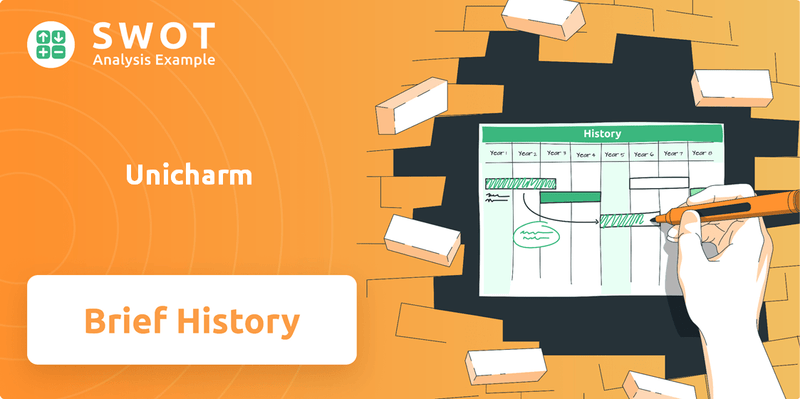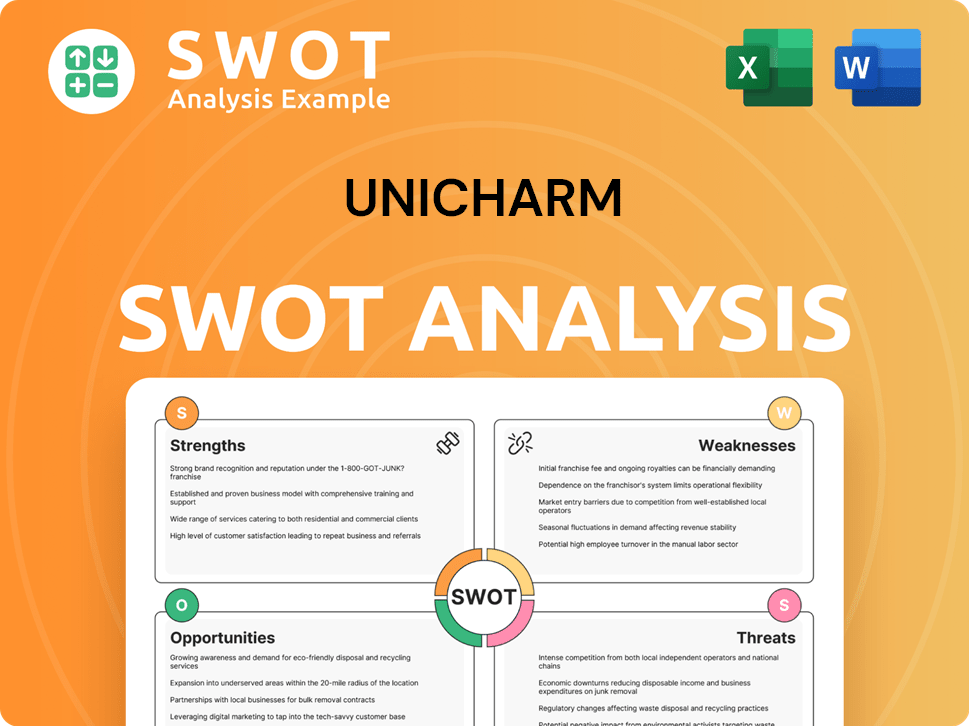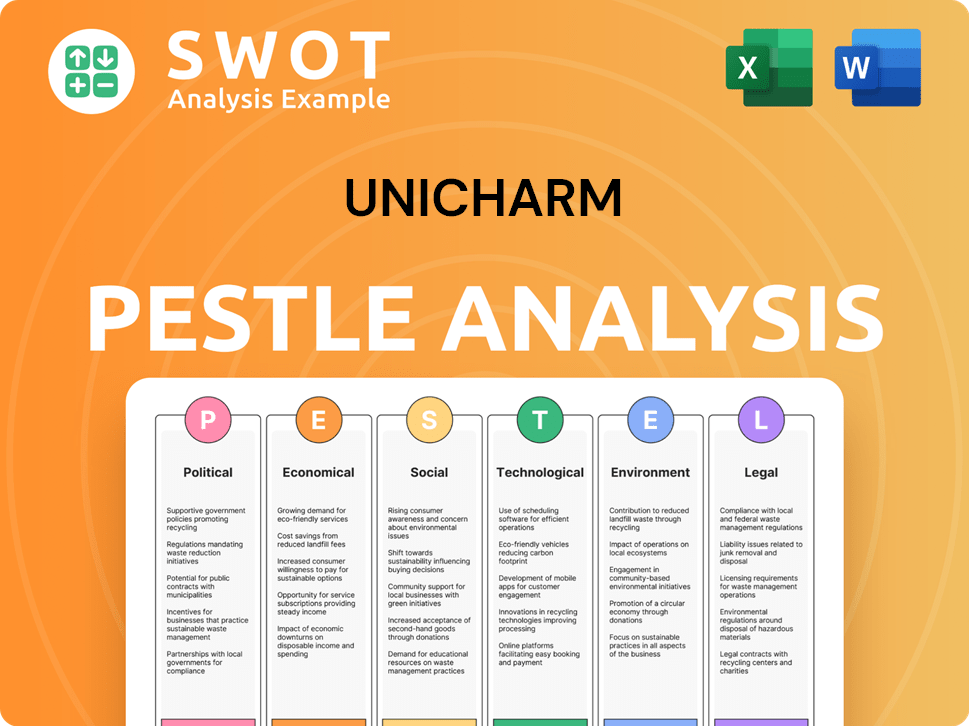Unicharm Bundle
How Did Unicharm Transform from Building Materials to a Global Consumer Giant?
Unicharm, a name synonymous with everyday convenience, has a fascinating backstory that few are aware of. From its humble beginnings in 1961, this Japanese company has evolved dramatically, leaving an indelible mark on the consumer products industry. Its journey, marked by strategic pivots and innovative offerings, showcases a remarkable ability to adapt and thrive. Learn about the Unicharm SWOT Analysis to understand its current market position.

This article will delve into the brief history of Unicharm, exploring its transformation from a building materials manufacturer to a global leader in disposable hygiene products and pet care. We'll uncover the key milestones that shaped Unicharm's trajectory, examining its innovative spirit and strategic decisions. Discover how this Japanese company navigated a dynamic market to achieve its present-day status, becoming a household name worldwide.
What is the Unicharm Founding Story?
The Revenue Streams & Business Model of Unicharm traces back to October 2, 1961, when Keiichiro Takahara established the company. Initially, it was a manufacturer of building materials, specifically wood fiberboards. Takahara's vision quickly evolved as he recognized an unmet need in the market for disposable hygiene products.
This shift marked a pivotal moment, transforming the company's strategic direction. The early focus on industrial materials gave way to consumer goods, with sanitary napkins being the first product. This was a bold move, considering the limited availability and acceptance of disposable hygiene products in Japan at the time.
The company name, 'Unicharm,' was chosen to convey universal appeal. The post-war Japanese context, with its rapid industrialization, provided a favorable environment for consumer-oriented businesses. The company's early success was built on overcoming cultural barriers and educating consumers about the benefits of disposable hygiene.
Here are some key facts about the founding of the Unicharm company:
- Founded on October 2, 1961, by Keiichiro Takahara.
- Initially focused on manufacturing building materials, specifically wood fiberboards.
- Pivoted to consumer goods, with the first product being sanitary napkins.
- The name 'Unicharm' was chosen to reflect universal appeal.
- The company's early success was influenced by post-war Japan's industrialization and changing consumer habits.
Unicharm SWOT Analysis
- Complete SWOT Breakdown
- Fully Customizable
- Editable in Excel & Word
- Professional Formatting
- Investor-Ready Format

What Drove the Early Growth of Unicharm?
The early growth of the Unicharm company was defined by a strategic shift towards disposable hygiene products, a move that set the stage for its future success. Following the launch of its initial sanitary napkins in 1963, the company rapidly expanded its product range. This expansion was critical in establishing the company as a leader in the hygiene market. This period saw the company laying the groundwork for its future dominance in the Japanese company landscape and beyond.
In 1971, Unicharm introduced its first paper diapers, 'Charm Baby,' marking its entry into the baby care market. This strategic move positioned the company as an innovator in a high-growth category. The company's focus on quality and convenience resonated with Japanese consumers, driving early sales milestones. This expansion was a key step in the Unicharm history.
The initial team expansion focused on research and development to refine product designs and manufacturing processes, alongside sales and marketing personnel to build distribution networks. Dedicated hygiene product manufacturing facilities were established in Japan, increasing production capacity. This allowed Unicharm to meet growing consumer demand effectively. This growth was critical for the company's success.
Unicharm's internationalization began with its entry into Taiwan in 1984, followed by expansion into other Asian countries. This strategy was crucial for sustained growth, tapping into rapidly developing economies. The company's global presence expanded significantly during this period. For more insights, see the Marketing Strategy of Unicharm.
The market reception for Unicharm's innovative products was largely positive, despite initial educational efforts required for disposable hygiene products. The company's early mover advantage and continuous product improvement helped it maintain a strong position. Strategic shifts included a relentless focus on consumer needs and a commitment to technological innovation. By the late 1980s, Unicharm had become a leading hygiene product manufacturer in Japan.
Unicharm PESTLE Analysis
- Covers All 6 PESTLE Categories
- No Research Needed – Save Hours of Work
- Built by Experts, Trusted by Consultants
- Instant Download, Ready to Use
- 100% Editable, Fully Customizable

What are the key Milestones in Unicharm history?
The Unicharm history is marked by significant milestones in the disposable hygiene products industry. The Unicharm company has consistently expanded its product lines and market presence, establishing itself as a key player in the global market. The Japanese company has shown remarkable growth and adaptability.
| Year | Milestone |
|---|---|
| 1961 | The company was founded, marking the beginning of its journey in the personal care industry. |
| 1981 | 'MamyPoko' diapers were launched, revolutionizing the baby care market with superior absorbency. |
| 1982 | 'Sofy' sanitary napkins were introduced, quickly becoming a leading brand due to their advanced design. |
| Early 2000s | The company expanded its product portfolio to include pet care products, which proved to be a successful venture. |
| Ongoing | Continuous investment in research and development, focusing on sustainable materials and environmentally friendly production processes. |
Unicharm has consistently focused on product innovation, introducing groundbreaking items to meet consumer needs. The company's commitment to research and development has led to the creation of highly absorbent and comfortable products.
The 'MamyPoko' diapers featured superior absorbency and fit, setting a new standard in the baby care market. This innovation significantly improved the quality of life for both babies and parents.
'Sofy' sanitary napkins were designed for enhanced comfort and effectiveness, quickly gaining popularity among consumers. This product launch solidified the company's position in the feminine care market.
The 'Lifree' brand addressed an underserved demographic with dignity and effective solutions. This move showcased the company's commitment to providing comprehensive personal care products.
The company is investing heavily in research and development to create products using sustainable materials. This reflects a broader industry trend toward environmental responsibility.
The company has expanded its product portfolio to include pet care products, which has proven to be a highly successful venture. This diversification has contributed to the company's overall growth.
Ongoing advancements in absorbent technology have led to more efficient and comfortable products. This focus on innovation helps maintain the company's competitive edge.
Unicharm has faced challenges such as economic downturns and intense competition within the disposable hygiene products sector. The company has continuously adapted its strategies to overcome these obstacles.
Economic downturns in key markets have impacted consumer spending, requiring adjustments to pricing and product offerings. Adaptability is crucial for maintaining market share during economic instability.
Competition from both local and international players necessitates continuous innovation and marketing efforts. The company must stay ahead of the curve to maintain its position.
Ensuring consistent quality across diverse manufacturing sites and managing raw material costs can be complex. Efficient supply chain management is essential for profitability.
The intensely competitive nature of the consumer goods industry implies ongoing challenges in product development and market acceptance. Thorough market research is essential for successful product launches.
Varying regulatory landscapes across different countries require careful navigation to ensure compliance. Adapting to local regulations is crucial for global expansion.
Maintaining a strong brand reputation is critical in a competitive market. Consistent quality and effective marketing are essential for building and protecting brand value.
For more insights into Unicharm's strategic approach, consider reading about the Growth Strategy of Unicharm.
Unicharm Business Model Canvas
- Complete 9-Block Business Model Canvas
- Effortlessly Communicate Your Business Strategy
- Investor-Ready BMC Format
- 100% Editable and Customizable
- Clear and Structured Layout

What is the Timeline of Key Events for Unicharm?
The Unicharm company has a rich history marked by strategic product launches and global expansion, evolving from its founding in 1961 into a leading provider of disposable hygiene products. The Japanese company has consistently innovated and adapted to meet changing consumer needs, establishing a strong presence in various markets and product categories.
| Year | Key Event |
|---|---|
| 1961 | Founding of Unicharm Corporation. |
| 1963 | Launch of the first sanitary napkin product. |
| 1971 | Introduction of 'Charm Baby' paper diapers. |
| 1981 | Launch of 'MamyPoko' diapers, establishing a strong presence in baby care. |
| 1982 | Introduction of 'Sofy' sanitary napkins, becoming a flagship feminine care brand. |
| 1984 | First international expansion into Taiwan. |
| 1987 | Launch of 'Lifree' adult incontinence products. |
| 1990s | Significant expansion across Southeast Asia and China. |
| 2000s | Continued global expansion, focusing on emerging markets. |
| 2004 | Entry into the pet care market with 'Deo-Toilet' and 'Deo-Clean' brands. |
| 2010s | Increased focus on sustainability and environmentally friendly product development. |
| 2023 | Unicharm announces its commitment to achieving carbon neutrality by 2050, aligning with global environmental goals. |
| 2024 | Continued strong performance in Asian markets, with a focus on premiumization and digital engagement. |
| 2025 | Expected continued growth in emerging markets, leveraging e-commerce platforms. |
Unicharm is focused on sustainable growth, emphasizing environmentally friendly product development and manufacturing processes. The company aims to reduce its carbon footprint and promote eco-conscious practices. This includes using sustainable materials and reducing waste across its operations.
Digital transformation is a key strategic initiative for Unicharm. The company is enhancing its e-commerce capabilities and leveraging data analytics to better understand consumer behavior. This allows for personalized product offerings and improved customer engagement.
Unicharm is targeting continued market penetration in emerging economies, especially in Asia. The company is leveraging its established brands and strong distribution networks. Rising incomes in developing countries are expected to fuel demand for their products.
Product innovation remains a central focus for Unicharm, particularly in developing more sustainable materials. This includes advancements in baby care, feminine care, and adult incontinence products. The company is investing in research and development to meet evolving consumer needs.
Unicharm Porter's Five Forces Analysis
- Covers All 5 Competitive Forces in Detail
- Structured for Consultants, Students, and Founders
- 100% Editable in Microsoft Word & Excel
- Instant Digital Download – Use Immediately
- Compatible with Mac & PC – Fully Unlocked

Related Blogs
- What is Competitive Landscape of Unicharm Company?
- What is Growth Strategy and Future Prospects of Unicharm Company?
- How Does Unicharm Company Work?
- What is Sales and Marketing Strategy of Unicharm Company?
- What is Brief History of Unicharm Company?
- Who Owns Unicharm Company?
- What is Customer Demographics and Target Market of Unicharm Company?
Disclaimer
All information, articles, and product details provided on this website are for general informational and educational purposes only. We do not claim any ownership over, nor do we intend to infringe upon, any trademarks, copyrights, logos, brand names, or other intellectual property mentioned or depicted on this site. Such intellectual property remains the property of its respective owners, and any references here are made solely for identification or informational purposes, without implying any affiliation, endorsement, or partnership.
We make no representations or warranties, express or implied, regarding the accuracy, completeness, or suitability of any content or products presented. Nothing on this website should be construed as legal, tax, investment, financial, medical, or other professional advice. In addition, no part of this site—including articles or product references—constitutes a solicitation, recommendation, endorsement, advertisement, or offer to buy or sell any securities, franchises, or other financial instruments, particularly in jurisdictions where such activity would be unlawful.
All content is of a general nature and may not address the specific circumstances of any individual or entity. It is not a substitute for professional advice or services. Any actions you take based on the information provided here are strictly at your own risk. You accept full responsibility for any decisions or outcomes arising from your use of this website and agree to release us from any liability in connection with your use of, or reliance upon, the content or products found herein.